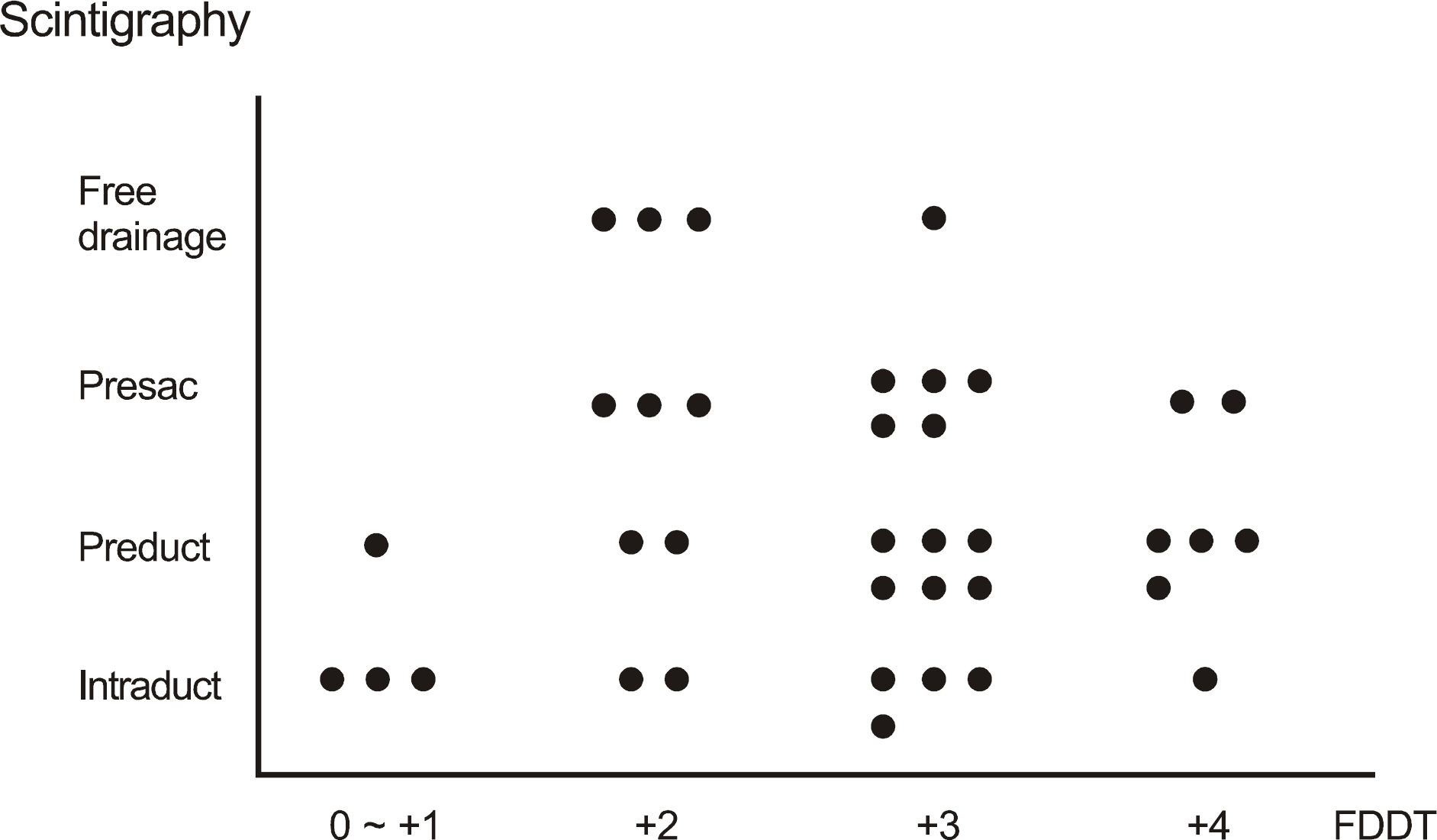J Korean Ophthalmol Soc.
2011 Sep;52(9):1013-1018.
Comparison of Lacrimal Scintigraphy and Fluorescein Dye Disappearance Test in Functional Blockage of Lacrimal System
- Affiliations
-
- 1Department of Ophthalmology, Chung-Ang University College of Medicine, Seoul, Korea. lk1246@hanmail.net
Abstract
- PURPOSE
To compare the usefulness of fluorescein dye disappearance test (FDDT) and dacryoscintigraphy in functional lacrimal blockage.
METHODS
The present study included with 24 patients (37 eyes), who were diagnosed with functional lacrimal blockage and underwent silicone tube insertion in our clinic. Compared to postoperative symptom improvement, the results of FDDT and dacryoscintigraphy were analyzed.
RESULTS
Significant correlations were observed with FDDT and dacryoscintigraphy results in 29 eyes before surgery. In 33 eyes, there were post-operative symptom improvements and the sensitivity of each exam was estimated at 87.8% in FDDT and 90.9% in dacryoscintigraphy. After intubation normal findings were observed in each examination and the symptoms improved in 7 out of 8 eyes.
CONCLUSIONS
Both FDDT and dacryoscintigraphy were considered sensitive and efficient methods in the diagnosis and evaluation of functional lacrimal blockage. Both methods require caution regarding misinterpretation by false negatives and may be complementary as well as increasing diagnostic accuracy.
MeSH Terms
Figure
Reference
-
References
1. Cuthbertson FM, Webber S. Assessment of functional nasolacrimal duct obstruction-a survey of ophthalmologists in the southwest. Eye (Lond). 2004; 18:20–3.
Article2. Lee SU, Kim EH, Lee JE, Lee JS. The clinical outcome of silicone tube intubation according to nasolacrimal duct obstruction sites by dacryoscintigraphy. J Korean Ophthalmol Soc. 2006; 47:863–70.3. Kim CH, Lew H, Yun YS. Correspondence among the canaliculus irrigation test, dacryocystography and Jones test in the epiphora patients. J Korean Ophthalmol Soc. 2007; 48:1017–22.
Article4. MacEwen CJ, Young JD. The fluorescein disappearance test (FDT): an evaluation of its use in infants. J Pediatr Ophthalmol Strabismus. 1991; 28:302–5.
Article5. Zappia RJ, Milder B. Lacrimal drainage function. 2. The fluorescein dye disappearance test. Am J Ophthalmol. 1972; 74:160–2.6. O'Donnell BA, Clement CI. Assessing patients with epiphora who are patent to syringing: clinical predictors of response to dacryocystorhinostomy. Ophthal Plast Reconstr Surg. 2007; 23:173–8.7. Zappia RJ, Milder B. Lacrimal drainage function. 1. The Jones fluorescein test. Am J Ophthalmol. 1972; 74:154–9.8. Rossomondo RM, Carlton WH, Trueblood JH, Thomas RP. A new method of evaluating lacrimal drainage. Arch Ophthalmol. 1972; 88:523–5.
Article9. Amanat LA, Hilditch TE, Kwok CS. Lacrimal scintigraphy.Ⅱ. Its role in the diagnosis of epiphora. Br J Ophthalmol. 1983; 67:720–8.10. Jones LT. The cure of epiphora due to canalicular disorders, trauma and surgical failures on the lacrimal passages. Trans Am Acad Ophthalmol Otolaryngol. 1962; 66:506–24.11. Woo JM, Shin DM, Park JM, Ahn HB. The effects of lateral tarsal strip procedure on the functional nasolacrimal duct obstruction. J Korean Ophthalmol Soc. 2006; 47:1375–80.12. Jung HS, Kwak KS. Quantitative lacrimal scintigraphy, after dacryocystorhinostomy and conjunctivodacryocystorhinostomy with Jones' tube. J Korean Ophthalmol Soc. 1987; 28:251–7.13. Kim HY, Lee SY, Jang JW. Efficacy of dacryoscintigraphy in patients with functional block of lacrimal drainage system. J Korean Ophthalmol Soc. 1999; 40:10–5.14. Lee HH, Byun YJ. Dacryoscintigraphy: The assessment of epiphora in children. J Korean Ophthalmol Soc. 1995; 36:1429–34.15. von Denffer H, Dressler J, Pabst HW. Lacrimal dacryoscintigraphy. Semin Nucl Med. 1984; 14:8–15.16. Peter NM, Pearson AR. Comparison of dacryocystography and lacrimal scintigraphy in the investigation of epiphora in patients with patent but nonfunctioning lacrimal systems. Ophthal Plast Reconstr Surg. 2009; 25:201–5.
Article17. Wearne MJ, Pitts J, Frank J, Rose GE. Comparison of dacryocystography and lacrimal scintigraphy in the diagnosis of functional nasolacrimal duct obstruction. Br J Ophthalmol. 1999; 83:1032–5.
Article18. Chung YA, Yoo leR, Oum JS, et al. The clinical value of dacryoscintigraphy in the selection of surgical approach for patients with functional lacrimal duct obstruction. Ann Nucl Med. 2005; 19:479–83.
Article19. Huh DW, Son MG, Kim YD. Silicone intubation for functional nasolacrimal duct obstruction. J Korean Ophthalmol Soc. 2000; 41:2303–7.20. Jeong HW, Cho NC, Ahn M. Result of silicone tube intubation in patients with epiphora who showing normal finding in dacryocystography. J Korean Ophthalmol Soc. 2008; 49:706–12.
Article21. Angrist RC, Dortzbach RK. Silicone intubation for partial and total nasolacrimal duct obstruction in adults. Ophthal Plast Reconstr Surg. 1985; 1:51–4.
Article22. Lee CO, Kim JH, Jong SH. Success rate of silicone tube intubation. J Korean Ophthalmol Soc. 1997; 38:1921–5.23. Conway ST. Evaluation and management of “functional” nasolacrimal blockage: results of a survey of the American Society of Ophthalmic Plastic and Reconstructive surgery. Ophthal Plast Reconstr Surg. 1994; 10:185–7.24. Chung WS, Park NG. Functional obstruction of the lacrimal draings system. J Korean Ophthalmol Soc. 1995; 36:1435–8.25. Shin CH, Woo KI, Chang HR. Evaluation of the functional nasolacrimal duct obstruction with digital subtraction dacryocystography. J Korean Ophthalmol Soc. 2003; 44:529–33.
- Full Text Links
- Actions
-
Cited
- CITED
-
- Close
- Share
- Similar articles
-
- Secretion and Excretion of Tears in Normal Eyes of Korean
- A Simple Test for Epiphora Caused by Punctal Stenosis
- Efficacy of Dacryoscintigraphy in Patients with Functional Block of Lacrimal Drainage System
- Functional Obstruction of The Lacrimal Draings System
- A Clinical Study in Patients with Membranous Obstruction of Internal Ostium and No Epiphora Who Underwent Endonasal Dacryocystorhinostomy


